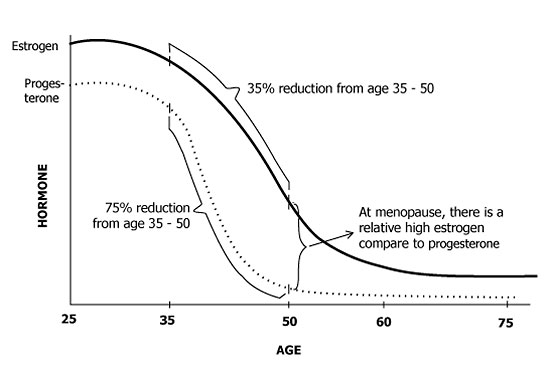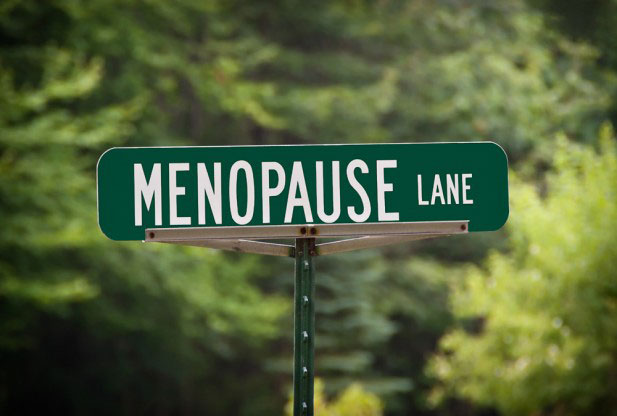Update: 22 November 2024
Menopause
Author: Julie Casper, C. Ac.
Menopause is natural. The average age for a woman's last period is 51, although it can occur much earlier or as late as age 60. It should be a healthy transition in any woman's life. Menopause is embraced and celebrated in many traditional cultures.

In a woman's early years, estrogen and progesterone levels trigger the menstrual cycle. These hormone levels begin to decline with age, and monthly periods may vary from long-to-short and light-to-heavy. In some months they may not take place at all. Eventually, the levels of estrogen and progesterone decrease dramatically, resulting in the end of menstrual cycles — or menopause.
What Causes Menopause?

Reduction in hormone production. From age 35 to 50 there is a 35% reduction in estrogen, and a 75% reduction in progesterone. This means that at menopause, estrogen levels are twice as high as progesterone, creating an estrogen-dominant condition.
Menopause occurs in most women between the ages of 45 and 50. Natural menopause is apparently caused by reduced function of the ovaries, When all primordial follicles (eggs) are used up, estrogen levels begin to decrease and the menstrual cycle ceases.
Some women experience sudden, premature menopause because of cancer medications or complete or even partial hysterectomies. While removing both the ovaries and the uterus will result in menopause, even removing only the uterus can sometimes hasten menopause. In the case of premature menopause, extra care must be taken to protect the body from more years without the bone and heart protection of estrogen and progesterone. Each woman's experience with menopause is different. Many women have few problems, while others find this phase of life extremely difficult and troubling.
Common Symptoms of Menopause
Symptoms that result from hormone fluctuation are often associated with menopause.
- Hot flashes and night sweats
- Difficulty sleeping
- Decreased libido
- Vaginal dryness and lack of skin elasticity
- Depression
- Irritability
- Poor memory
- Menstrual irregularities (periods that are infrequent and light or frequent and heavy)
- Increased frequency of urinary tract or vaginal infections
The Adrenal Glands and Menopause
The adrenal glands produce small quantities of both male and female sex hormones. Ideally, the adrenal glands will produce adequate estrogen to avoid symptoms when ovarian hormone production ceases. Due to numerous environmental stressors, and nutritional deficiencies that commonly result in copper imbalance, many women today suffer from ‘chronic-fatigue,’ or adrenal insufficiency. Also, without adequate adrenal capability, if the ovaries cease to function properly, hot flashes, vaginal dryness and increased demineralization of the bones can occur. Adrenal exhaustion may also contribute to the early cessation of menstruation in women who exercise heavily, are vegetarians, or are nutritionally deficient.
Sluggish Metabolism and Menopause
At the time of menopause, the adrenal glands should produce sufficient estrogen and progesterone to avoid unpleasant menopausal symptoms. However, in many women the adrenal glands are depleted. When the ovaries stop producing hormones, the adrenals do not produce enough to make up the difference and symptoms occur. In addition to physical symptoms, depression, crying and other emotional symptoms can be traced to adrenal insufficiency.
The most important part of the solution to menopausal symptoms is to improve the activity of the adrenal glands. This should always be the first goal before one resorts to replacement hormones, herbs, soy products or other treatments.
Liver Toxicity and Estrogen
Estrogen is detoxified in the liver. In slow metabolizers, the liver is often congested. If estrogen is not properly detoxified, an excess remains in the blood. This can make an individual estrogen dominant even though one is not producing high amounts of estrogen. This can also ruin the accuracy of saliva hormone tests.
Certain pesticides and other chemicals, including some found in soy, mimic the effects of estrogen. At times this can be of benefit. At others it is decidedly harmful. Chemicals may also cause an individual to become estrogen dominant and skew tests for estrogen although one is not producing much estrogen.
Conventional Treatment of Menopause
Once considered the mainstay of conventional treatment for menopausal symptoms, hormone replacement therapy (HRT), consisting of estrogen and progestin (synthetic progesterone), may be prescribed by conventional allopathic physicians to alleviate the symptoms associated with menopause and prevent osteoporosis.
Potential side effects and risks of HRT
This list of risks observed with HRT use varies by a woman's age; her environmental, nutritional, and lifestyle factors; and her genetics and medical history. The type, combination, and dosage of hormones used; the route of delivery; and duration of treatment also greatly influence risks.
- Endometrial bleeding
- Breast tenderness
- Increased breast density, higher rates of abnormal mammograms and breast biopsies
- Increased risk of cancers, including breast, ovarian, lung, and malignant melanoma
- Cardiovascular events (e.g., heart attack, stroke, cardiovascular death)
- Gallbladder disease
- Venous thromboembolic events (blood clots)
- Reduced insulin sensitivity
- Brain atrophy, increased risk of dementia, decline in memory and cognition
- Cataracts
Today, HRT is being prescribed less frequently because of a 2002 report in the Journal of the American Medical Association. The report announced a three-year early halt of a HRT study that was in progress due to "long-term risks associated with HRT." The study found that women taking a combination of equine estrogen and synthetic progesterone (in this case Prempro® – the most common HRT in use in the United States at the time) had double the risk for blood clots, a 29 percent increased risk for heart disease, a 41 percent increased risk for stroke, and a 26 percent increased risk for invasive breast cancer as compared to women taking a placebo. Most of the major media networks reported this disturbing information. Today, most women are seeking better alternatives.
Bio-identical hormones are among the alternatives being recommended by some health-care practitioners looking for a safer option. These consist of estrogen and progesterone synthesized from wild yam. Bio-identical hormones more closely resemble the hormones produced in the body than the conventional HRT and generally results in fewer side effects. Bio-identical hormones are prescription medications that must be prescribed by a health-care practitioner.
Surgically or Chemically-induced Menopause
The information above applies as well to menopausal symptoms due to oophorectomy, radiation or chemotherapy. In every case, the adrenal glands should produce enough hormones to avoid hot flashes and other symptoms. Symptoms occur when the adrenals are depleted and the liver is unable to detoxify estrogen, causing higher than normal circulating estrogen in the blood.
Symptomatic Treatment with Soy Products
Some health authorities recommend eating genisten and other phytochemicals found in soy as treatment for menopausal symptoms. We do not recommend soy, except for occasional tempeh, miso or natto. The harmful qualities of soy have been minimized in these traditional fermented soy products. Soy powders and other soy products contain enzyme inhibitors, chemical processing residues and thyroid inhibitors. Soy products are best avoided.
Avoiding Negative Symptoms of Menopause

Menopause need not be a difficult experience. With proper nutritional support, this significant transition can be like a pleasant walk down memory lane.
The conventional medical treatment for menopausal symptoms is estrogen, preferably accompanied by progesterone. This can be effective, but in many women causes adverse reactions. There is also concern about an increased risk of cancer and cardiovascular disease due to estrogen therapy. For women who cannot or do not wish to take estrogen, nutritional approaches offer an alternative that is effective for improving overall cellular health, which in turn, can result in a symptom free, or at least comfortable, menopause transition.
Improving nutrition is an excellent way to restore hormone production. In women with a slow metabolism, typically the adrenal and thyroid glands are exhausted also. Restoring these glands requires specific minerals and synergistic vitamins, prescribed in the correct amounts for your biochemical individuality. Because of the complexity and individual nature of the problem, it is best to work with a qualified health professional.
Toxic metals and chemicals can interfere with glandular activity. For example, excessive copper, mercury, or cadmium in tissues often contribute to, or even cause many symptoms. Excessive worry, inadequate diet, or other lifestyle factors can be important contributors to biochemical imbalances. Restoring the entire biochemical energy system may also be needed.
Menopause Symptom Reduction -- using Nutrition
Improving nutrition is both safe and effective for reducing undesirable symptoms.
- Eat nutrient-rich organically grown food.
- Avoid sugar-containing products (including fruit juice).
- Avoid or eliminate wheat
- Avoid or eliminate commercial dairy products.
- Eliminate chemical additives found in processed packaged food products.
General Dietary Suggestions
Additional Dietary Tips
Individuals with a slow metabolic-rate should eat protein with each meal. Increase the amount of vegetables with generous servings at two meals daily. Sleep is important, ideally eight to nine hours of sleep a night. This helps to rejuvenate the adrenals and facilitate liver detoxification. If you are having difficulty sleeping you may have an issue with melatonin production. Talk with a practitioner experienced in amino therapy for help with this problem.
During menopause, the need increases for certain nutrients; therefore, a woman will generally benefit from a biochemically personalized vitamin and mineral supplement program. Most women are aware of the need for adequate calcium as they age to support good bone health, but bones are made up of more than just calcium. Maintaining healthy bones requires a number of vitamins and minerals, including vitamins D and K, the B vitamins, magnesium, and boron. And taking too much calcium can cause many health problems, be sure to know your actual needs through hTMA screening.
Women need to maintain good cardiovascular health after menopause. Thus, maintaining healthy blood vessels, cholesterol levels, and antioxidant levels becomes more essential as women age. A safe and effective dietary supplement protocol based on your individual biochemical needs can alleviate most uncomfortable menopausal symptoms, including hot flashes, night sweats, mood swings, and sleeplessness. hTMA screening provides hard test data that replaces the guesswork approach to an individual's supplement prescription. hTMA mineral balancing therapy is effective for symptomatic treatment and biochemical balancing.
Unexpected Return of Menstruation
Menstrual periods may return when mineral balancing therapy is incorporated. This phenomena is more common with younger women who experience early menopause. Although unexpected, this actually is a positive indication of improving health. Menopause occurs when hormones levels decrease, indicating that child-bearing is no longer healthful. Biochemical balancing with hTMA can significantly restore health so that child-bearing once again becomes viable and menstrual periods return.
References
- Menopause – A Natural Biological Process, Not an Estrogen Deficiency Disease Thorne Research
- Study Reveals Harms of Hormone Replacement Therapy Women's Health Initiative (WHI)